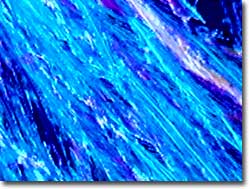Chemical Crystal Movie Gallery
Piperazine Time Lapse Sequence
Piperazine is an anthelmintic drug used in the treatment of endoparasitic "worm" infestations in humans and domestic animals. As a cure for pinworms and common roundworms, piperazine paralyzes the parasites, allowing them to pass in the feces.

As the simplest cyclic member of the ethyleneamine family of organic compounds, piperazine includes two secondary amine groups, and has a molecular weight of 86.14 in its anhydrous form. The boiling point for the typical 68-percent aqueous piperazine solution is 117.8 degrees Celsius while the freezing point is 48 degrees Celsius. Alternative names include diethylenediamine and hexahydropyrazine, as well as several trade or brand names. Forming a white or transparent crystalline substance, piperazine and its derivatives are being examined by the U.S. Department of Labor's Occupational Safety & Health Administration (OSHA) and its British counterpart organization, in an effort to establish worker exposure limits because of a suspected risk of developing clinical asthma through exposure to the chemical.
The popular little blue pill for treating male impotence, Viagra, is a synthetic heterocyclic piperazine derivative. Other pharmaceuticals derived from piperazine include antihistamines and motion-sickness drugs that act similarly to Dramamine. An aqueous solution of piperazine is commonly used in the manufacture of polyamide resins, epoxy curing agents, and urethanes applied as spray foams, building panels, elastomers, and as utilized for automobile and appliance construction. As a restricted-use pesticide, diethylenediamine is marketed as triforine and is labeled to treat a wide variety of food crops, cotton, tobacco, and many horticultural species for fungal infections.
Piperazine Time Lapse Sequence #1 - A 31-image time-lapse sequence acquired using polarized illumination illustrates a rapidly advancing crystallization growth front that moves diagonally across the viewfield.
Contributing Authors
Omar Alvarado, Thomas J. Fellers and Michael W. Davidson - National High Magnetic Field Laboratory, 1800 East Paul Dirac Dr., The Florida State University, Tallahassee, Florida, 32310.
BACK TO THE CHEMICAL CRYSTAL MOVIE GALLERY
BACK TO THE DIGITAL IMAGE GALLERIES
Questions or comments? Send us an email.
© 1995-2025 by Michael W. Davidson and The Florida State University. All Rights Reserved. No images, graphics, software, scripts, or applets may be reproduced or used in any manner without permission from the copyright holders. Use of this website means you agree to all of the Legal Terms and Conditions set forth by the owners.
This website is maintained by our
Graphics & Web Programming Team
in collaboration with Optical Microscopy at the
National High Magnetic Field Laboratory.
Last Modification Friday, Nov 13, 2015 at 01:19 PM
Access Count Since September 17, 2002: 18173
Visit the website of our partner in introductory microscopy education:
|
|
